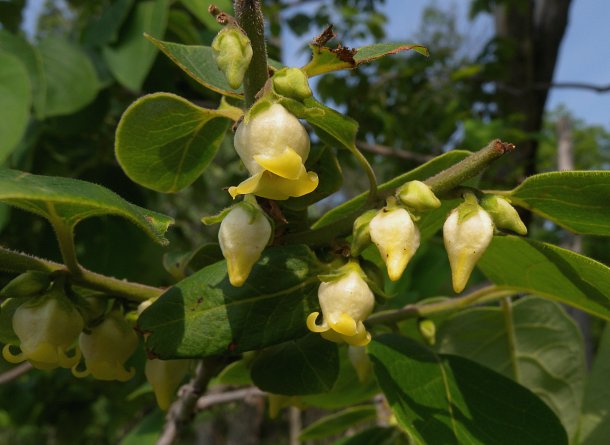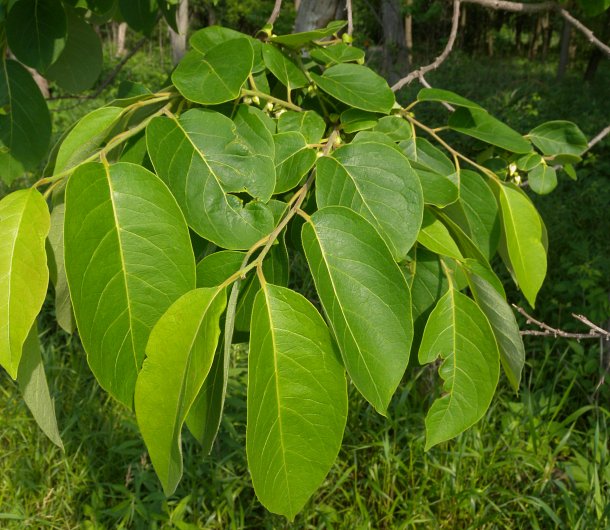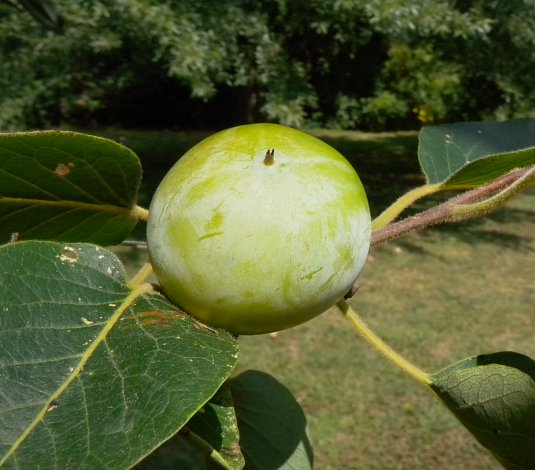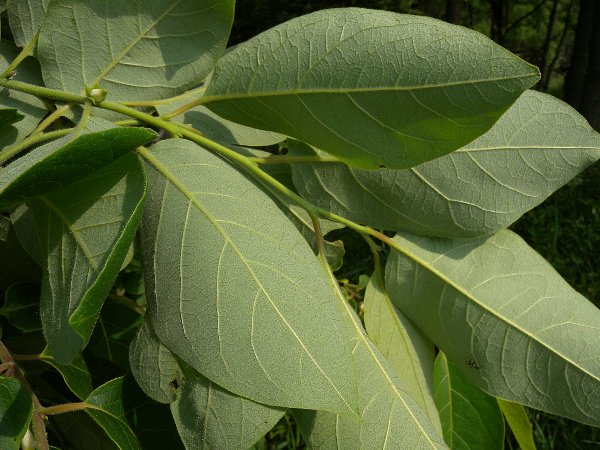Description: This medium-sized tree is typically 30-70' tall, consisting of an erect trunk about 1-2' across and an oblongoid to ovoid crown. On mature trees, the trunk bark is blackish gray and deeply furrowed into small flat-topped scales that are shaped like irregular squares or rectangles. The bark of branches is gray or brown and more smooth. Young leafy shoots are usually pubescent, rarely glabrous. The alternate leaves are 2½-6" long and 1-2" across; they are elliptic-oblong to ovate in shape and smooth along their margins. The upper surface of the leaf blades is medium to dark green and glabrous, while the lower surface is pale green and short-pubescent to nearly glabrous. The slender petioles are about ¼–1" long, light green, and short-pubescent to nearly glabrous. Leaf venation is pinnate. American Persimmon is dioecious, producing trees with either all male (staminate) flowers or all female (pistillate) flowers. Male flowers are arranged in small clusters of 2-3 on short branching stalks. Individual male flowers are about 1/3" (8 mm.) long, consisting of an urn-shaped corolla with 4 recurved lobes (rarely 5), a short calyx with 4 teeth, and up to 16 inserted stamens.

Female flowers occur individually on very short stalks. Individual female flowers are about 2/3" long (16 mm.), consisting of an urn-shaped corolla with 4 recurved lobes (rarely 5), a calyx with 4 large teeth that are about 1/3" long (8 mm.), and a pistil with 4 inserted styles. For both male and female flowers, the corolla is usually white with yellow lobes, while the calyx is light green. The blooming period occurs from late spring to early summer. Fertile female flowers are replaced by fruits (large berries) about 1½-2" across. These fruits are globoid to subgloboid and glaucous; immature fruits are light green, while mature fruits are usually yellowish orange, orange, or reddish orange. Rarely, some trees produce dark purple to nearly black fruits (f. atra). Each fruit contains a fleshy pulp and 0-8 flattened seeds; it is very astringent while immature, but sweet-tasting when fully mature (resembling the flavor of dates). Fruits without seeds are produced parthenogenetically (without cross-fertilization from male trees); except for some cultivated varieties, such fruits are uncommon. The root system consists of a deep woody taproot.

Cultivation: American Persimmon is very adaptable, tolerating full sun to light shade, moist to dry conditions, and soil containing clay-loam, loam, silt, sand, and rocky material. It grows slowly. Fruit can be produced as early as 10-15 years. Because of its long taproot, this tree can be difficult to transplant.
Range & Habitat: The native American Persimmon is occasional in southern Illinois, and uncommon or absent elsewhere in the state (see Distribution Map). Illinois lies along the northern range limit of this species. Habitats include upland woodlands, bottomland woodlands (above the flood zone), flatwoods, barren savannas (both sandy & non-sandy), sandstone and limestone glades, fallow fields, abandoned pastures, and fence rows. This tree is a pioneer species that invades relatively open areas where there is less competition. Ultimately, it is replaced by larger canopy trees. American Persimmon is sometimes cultivated for its fruit and ornamental appearance.

Faunal Associations: According to Charles Robertson (1929), the flowers are cross-pollinated by long-tongued bees seeking nectar and pollen. Such floral visitors include honeybees, bumblebees, little carpenter bees (Ceratina), digger bees (Anthophora, Synhalonia), cuckoo bees (Nomada), leaf-cutting bees (Megachile), and mason bees (Osmia). Other insects that visit the flowers for nectar or pollen include Halictid bees (including green metallic bees), Syrphid flies, and skippers. Insects that feed destructively on American Persimmon include oligophagous larvae of a metallic wood-boring beetle (Agrilus diospyroides), larvae of long-horned beetles, leaf beetles, an oligophagous leafhopper (Erythridula cuneata), armored scale insects, mealybugs, oligophagous larvae of a shield-bearer moth (Coptodisca diospyriella), oligophagous larvae of two Noctuid moths, the Small Necklace Moth (Hypsoropha hormos) and Large Necklace Moth (Hypsoropha monilis), larvae of the Regal Moth (Citheronia regalis), and larvae of the Sculptured Moth (Eumarozia malachitana); see the Insect Table for more information.

While the fruits of American Persimmon are primarily distributed by mammals, some birds will peck and feed on the large fruits when they become ripe. These birds include the Mallard, Bobwhite Quail, Wild Turkey, Pileated Woodpecker, Yellow-bellied Sapsucker, Carolina Parakeet (now extinct), Northern Mockingbird, and American Robin. The Bird Table has a more complete list of these species. Mammals that feed on the fruits include the Gray Fox, American Red Fox, Raccoon, and White-tailed Deer. The Ornate Box Turtle also feeds on the fallen fruits of this tree, while the Woodland Vole (Microtus pinetorum) feeds primarily on the seeds (Martin et al., 1951/1961; Sotala & Kirkpatrick, 1973; Ernst et al., 1994). The Eastern Screech Owl sometimes uses this tree as a roost site (Belthoff & Ritchison, 1990).

Photographic Location: Along a sidewalk at Meadowbrook Park in Urbana, Illinois.
Comments: American Persimmon is the only member of the Ebony family in Illinois. Like ebony, its heartwood is nearly black. The fruits are edible to humans when they are fully ripe; they can be eaten fresh or used in puddings and cakes. The persimmon fruit that is occasionally found in grocery stores comes from another species, Diospyros kaki (Oriental Persimmon), which is native to China. Because of its distinctive trunk bark, flowers, and fruits, American Persimmon is an easy tree to identify. The rather ordinary-looking leaves can be confused with the leaves of other trees, particularly those lacking teeth along their leaf margins.